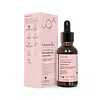What's inside
What's inside
 Key Ingredients
Key Ingredients

 Benefits
Benefits

 Ingredients Side-by-side
Ingredients Side-by-side

Water
Skin ConditioningTranexamic Acid
AstringentDimethyl Isosorbide
SolventEthoxydiglycol
HumectantPropanediol
SolventAlpha-Arbutin
AntioxidantPhenoxyethanol
PreservativeEthylhexylglycerin
Skin ConditioningHydroxyethylcellulose
Emulsion StabilisingBetaine
HumectantAloe Barbadensis Leaf Extract
Emollient1,2-Hexanediol
Skin ConditioningTriethanolamine
BufferingXanthan Gum
EmulsifyingGlycerin
HumectantRumex Occidentalis Extract
Skin ConditioningSodium Gluconate
Skin ConditioningCitrullus Lanatus Fruit Extract
Skin ConditioningPassiflora Edulis Fruit Extract
Skin ConditioningCamellia Sinensis Leaf Extract
AntimicrobialPyrus Malus Fruit Extract
Skin ConditioningCurcuma Longa Root Extract
MaskingWater, Tranexamic Acid, Dimethyl Isosorbide, Ethoxydiglycol, Propanediol, Alpha-Arbutin, Phenoxyethanol, Ethylhexylglycerin, Hydroxyethylcellulose, Betaine, Aloe Barbadensis Leaf Extract, 1,2-Hexanediol, Triethanolamine, Xanthan Gum, Glycerin, Rumex Occidentalis Extract, Sodium Gluconate, Citrullus Lanatus Fruit Extract, Passiflora Edulis Fruit Extract, Camellia Sinensis Leaf Extract, Pyrus Malus Fruit Extract, Curcuma Longa Root Extract
Aloe Barbadensis Leaf
MaskingTranexamic Acid
AstringentNiacinamide
SmoothingGlycereth-26
HumectantBetaine
HumectantPropanediol
Solvent1,2-Hexanediol
Skin ConditioningSodium Hyaluronate
HumectantAllantoin
Skin ConditioningXanthan Gum
EmulsifyingCitric Acid
BufferingCamellia Sinensis Leaf
PerfumingSambucus Nigra Flower
Skin ConditioningMomordica Charantia Fruit Extract
Skin ConditioningLeontopodium Alpinum Callus Lysate
Skin Conditioning
 Reviews
Reviews

Ingredients Explained
These ingredients are found in both products.
Ingredients higher up in an ingredient list are typically present in a larger amount.
1,2-Hexanediol is a synthetic liquid and another multi-functional powerhouse.
It is a:
- Humectant, drawing moisture into the skin
- Emollient, helping to soften skin
- Solvent, dispersing and stabilizing formulas
- Preservative booster, enhancing the antimicrobial activity of other preservatives
Betaine is a common humectant (a substance that promotes retention of moisture). It's known to be gentle on the skin and can help balance hydration.
This ingredient is best for improving hydration and soothing irritated skin. Studies also show it helps even out skin tone.
Fun fact: Betaine is naturally created in the skin and body. The kind found within cosmetic products can be either plant-derived or synthetic.
Another name for betaine is trimethylglycine.
Learn more about BetainePropanediol is an all-star ingredient. It softens, hydrates, and smooths the skin.
It’s often used to:
Propanediol is not likely to cause sensitivity and considered safe to use. It is derived from corn or petroleum with a clear color and no scent.
Learn more about PropanediolTranexamic Acid is best used for treating hyperpigmentation, discoloration, and melasma. It can also help build a stronger skin barrier.
Once applied, Tranexamic Acid starts decreasing inflammation from UV exposure. Tranexamic Acid also prevents our skin cells from meeting the pigment production cells.
Its brightening property makes it great at reducing the appearance of acne scars and marks.
Fun fact: Tranexamic Acid is also a medication used to reduce heavy bleeding.
This acid is derived from lysine, an amino acid.
Learn more about Tranexamic AcidXanthan gum is used as a stabilizer and thickener within cosmetic products. It helps give products a sticky, thick feeling - preventing them from being too runny.
On the technical side of things, xanthan gum is a polysaccharide - a combination consisting of multiple sugar molecules bonded together.
Xanthan gum is a pretty common and great ingredient. It is a natural, non-toxic, non-irritating ingredient that is also commonly used in food products.
Learn more about Xanthan Gum